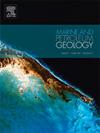西地中海中新世Castellón砂岩组作为潜在的地质碳储存地点的表征
IF 3.7
2区 地球科学
Q1 GEOSCIENCES, MULTIDISCIPLINARY
引用次数: 0
摘要
为了响应对欧洲工业中心脱碳的日益增长的兴趣,本研究考察了瓦伦西亚海槽中新世Castellón砂岩组地质碳储存的潜力。该储层单元位于巴伦西亚海槽的Ebro三角洲海域,主要由砂岩和砂质异质岩组成的硅质碎屑序列。基于对Amposta Marino C-2井取心剖面的研究,对该序列进行了沉积学表征,确定了多达11种岩相,包括砂岩、异质岩、钙屑岩和碳酸盐角砾岩。这些岩相可分为6个相组:1)河流河道,2)三角洲前缘近口坝,3)三角洲前缘远口坝,4)近前三角洲,5)远前三角洲,6)陆架滞后。在整个研究区域进行的地震地层分析指出,在研究区域的东北部,距离今天的埃布罗三角洲海岸线约30公里处,还存在三角洲平原沉积物。根据对这些相和地震相组合的解释,本文提出的沉积模式为晚中新世巴伦西亚海槽原埃布罗三角洲体系的河流主导、波浪影响三角洲。本研究认为,考虑到塔拉戈纳陆上工业综合体的邻近性和最佳储层特征,该易砂演化带是研究区地质碳储量的良好候选区。此外,Ebro页岩的厚层序也显示出作为下伏Castellón砂岩组纵向和横向封闭的巨大潜力。本文章由计算机程序翻译,如有差异,请以英文原文为准。
Characterization of the Miocene Castellón Sandstones Formation in the Western Mediterranean as a potential geological carbon storage site
In response to the growing interest in decarbonizing Europe's industrial hubs, this study examines the potential of the Miocene Castellón Sandstones Formation in the Valencia Trough for geological carbon storage. The proposed storage unit is represented by a siliciclastic succession formed mainly by sandstones and sandy heterolithics, in the Ebro Delta offshore area of the Valencia Trough. The sedimentological characterization of this succession, based on the study of a cored section from Amposta Marino C-2 well, has allowed to identify up to eleven lithofacies, comprising sandstones, heterolithics, calcarenites and carbonate breccias. These lithofacies can be grouped in six facies associations, including: 1) fluvial channel, 2) delta front proximal mouth bar, 3) delta front distal mouth bar, 4) proximal prodelta, 5) distal prodelta and 6) shelfal lag. The seismic stratigraphic analysis carried out throughout the study area points out to the additional presence of delta plain deposits in the northeastern sector of the study area, approximately at 30 km from the present-day Ebro delta shoreline. Based on the interpretation of these facies and seismic facies associations, the proposed depositional model consists of a river dominated, wave-influenced delta for the proto-Ebro deltaic system during the Late Miocene in the Valencia Trough. This study proposes that this sand-prone succession is presented as a good candidate for geological carbon storage in the study area, considering its proximity to the onshore Tarragona's industrial complex and its optimal reservoir characteristics. Additionally, the thick succession of the Ebro Shales also shows great potential as a vertical and lateral seal of the underlying Castellón Sandstones Formation.
求助全文
通过发布文献求助,成功后即可免费获取论文全文。
去求助
来源期刊

Marine and Petroleum Geology
地学-地球科学综合
CiteScore
8.80
自引率
14.30%
发文量
475
审稿时长
63 days
期刊介绍:
Marine and Petroleum Geology is the pre-eminent international forum for the exchange of multidisciplinary concepts, interpretations and techniques for all concerned with marine and petroleum geology in industry, government and academia. Rapid bimonthly publication allows early communications of papers or short communications to the geoscience community.
Marine and Petroleum Geology is essential reading for geologists, geophysicists and explorationists in industry, government and academia working in the following areas: marine geology; basin analysis and evaluation; organic geochemistry; reserve/resource estimation; seismic stratigraphy; thermal models of basic evolution; sedimentary geology; continental margins; geophysical interpretation; structural geology/tectonics; formation evaluation techniques; well logging.
 求助内容:
求助内容: 应助结果提醒方式:
应助结果提醒方式:


